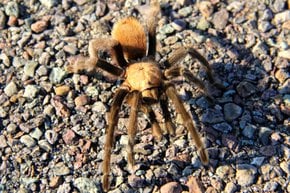Tarantula Migration in New Mexico 2026
Thousands of spiders can be spotted on roads, trails, and even in backyards
Best time: September–October
The Desert Tarantula, also called the Desert Blonde Tarantula, is common in New Mexico. These arachnids usually keep to themselves, spending most of their lives in burrows. However, in the fall, you can spot them almost everywhere, in particular, on the desert highways and roads. These large spiders covered with brown or tan hair leave their hideouts and roam the desert in search of mates. Their mating season lasts from September through October,
Where to spot tarantulas
Tarantulas are abundant in Northern New Mexico, around Santa Fe and Albuquerque. They can usually be easily spotted on Santa Fe Desert County Road 42 and along Highway 64 from Taos to Tres Piedras. Tarantulas are also common in central New Mexico on Highway 60 from Mountainair to Amerillo and in various parks and nature preserves.
Cerrillos Hills State Park
Cerrillos Hills State Park is located off the Turquoise Trail National Scenic Byway between Santa Fe and Albuquerque. In addition to beautiful vistas of Jemez Mountain, Sandia, Ortiz, and Sangre de Cristo Mountains, the park offers hiking trails, where it's possible to see tarantulas during their annual migration. The park is open daily, and sometimes employees organize guided tarantula-spotting tours. The best time to look for spiders is in the afternoon, around sunset.
Bandelier National Monument
Bandelier National Monument is a protected area and the ancestral lands of over 20 tribal nations. Located near Los Alamos, the picturesque site with rugged canyons and mesa is known for frequent tarantula sightings in the fall. You can hike one of the trails starting from the visitor center in Frijoles Canyon and leading to ancestral Pueblo sites.
Rio Grande del Norte National Monument
Rio Grande West Rim Trail, located within Rio Grande del Norte National Monument near Taos, is another excellent spider-spotting destination. An easy trail is about 3,8 miles (6 km) long and takes less than 1,5 hours to complete. As a bonus, you get to see stunning mountain views along the west rim of the Rio Grande Gorge.
Tarantula facts
Eight-legged tarantulas eat insects, which they kill, stinging them with venom. The venom is usually harmless for humans, but if you get bitten by a tarantula, you might feel a sting, similar to a bee's. Male spiders live only until they reach adulthood and can mate. They die shortly after mating unless female tarantulas kill and eat the poor fellows in the process of reproduction. On the contrary, females can live up to 25 years, giving life to thousands of offspring. A tarantula hawk is the only natural enemy for these arachnids.











































































